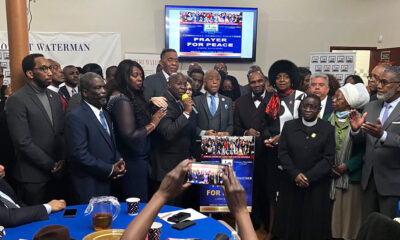Top Stories
Young Black Men Hit Hardest in Recession
Community Service Society Report
Only one in four young black men in New York City has a job, according to a report released by the Community Service Society of New York. The report, “Unemployment in New York City During the Recession and Early Recovery: Young Black Men Hit the Hardest,” illustrates that some demographic groups experienced the brunt of the recession more than others in terms of unemployment and job loss. Data for the report comes from the U.S. Department of Labor’s Bureau of Labor Statistics and, according to the report, in New York City the groups most affected by the recession were blacks, Latinos, youth and those with less than a high school or equivalent diploma.
Only one in four young black men in New York City has a job, according to a report released by the Community Service Society of New York. The report, “Unemployment in New York City During the Recession and Early Recovery: Young Black Men Hit the Hardest,” illustrates that some demographic groups experienced the brunt of the recession more than others in terms of unemployment and job loss. Data for the report comes from the U.S. Department of Labor’s Bureau of Labor Statistics and, according to the report, in New York City the groups most affected by the recession were blacks, Latinos, youth and those with less than a high school or equivalent diploma. “The recession has created a landscape of the unemployed and underemployed with particular catastrophic consequences for young African-American men,” said David R. Jones, president and CEO of the Community Service Society of New York. “We have long known the struggles of the more than 200,000 youth in New York City who are out of work and out of school. Now young black men between 16 and 24 years have become the banner of hopelessness, particularly here in New York City.”
According to CSS Labor Market Analyst and the report’s author Michelle Holder, the Bureau of Labor Statistics doesn’t compile city-level demographic employment data such as contained in the report, which outlines a difficult picture for young people, people of color, and the less educated in New York City. Ms. Holder added, in addition to unemployed youth, an estimated 30 percent of the unemployed in the city who previously held a job were unemployed for more than a year and, for those 55-64 years old, it took almost nine months to find a job. The top line report findings are: The largest increase in the unemployment rate occurred among working-age black men – it jumped from 9 percent in 2006 to 17.9 percent in 2009, an increase of nearly 9 percentage points.
The highest unemployment rate in 2009 was among men 16-24 years of age—their overall unemployment rate hit 24.6 percent during the recession and early recovery period. Breaking this down by race, young black men had the highest unemployment rate in this group—33.5 percent. While only one in four black men ages 16-24 have a job in the city, that figure drops to an astounding one in ten for young black men without a high school diploma.
Men 55-64 years old had the longest average spell of unemployment (approximately 39 weeks), but black New Yorkers had the highest percentage of those unemployed for more than a year; nearly 40 percent of black men and women who held a job before were unemployed for more than 12 months during the recession and early recovery. Overall, the average length of unemployment during the recession/early recovery period for all New Yorkers was just over six months. CSS published a report in 2004 on black male unemployment that explored the jobless and unemployment figures for this demographic; that report showed that only about 50 percent of all working-age black men held jobs in New York City at that time. While that figure has not changed significantly, noted Ms. Holder, the jobholding rate for young black men in particular is about half that level, and even lower for those who lack a high school or equivalent diploma.
Ms. Holder added, “From a public policy perspective, the main findings of my report are troubling because young African-American men without a job and without an adequate education become at-risk for involvement in the criminal justice system. As it is, black people are overrepresented among the incarcerated in this country. We need to ensure that young men of color in New York City are achieving the basic educational requirements to either get a decent job or go on to college if they so choose.”
Existing research has shown that the lack of a high school diploma as well as high unemployment puts young men at greater risk for incarceration. Also, there is strong evidence that shows that having a prison record is associated with subsequent poorer employment and wage outcomes. CSS continues to strongly advocate for quality General Educational Development (G.E.D.) programs as well as transitional workforce programs that help prepare young people to make successful transitions into either college or permanent, full-time employment. “Without work, without school and without a diploma, young African-American men are vulnerable for the prison pipeline,” Jones added. “The absence of training and jobs will provide a clear and uninterrupted pathway to poverty and potential imprisonment,” Jones added. For 165 years, the Community Service Society of New York has been the leading voice on behalf of low-income New Yorkers and continues to advocate for the economic security of the working poor in the nation’s largest city.














